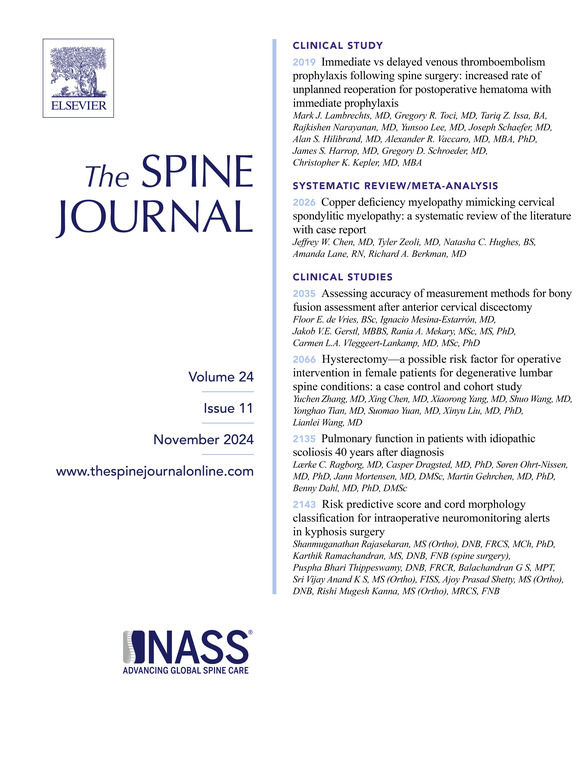Comparison between atlantoaxial and occipitocervical fusion: clinical implications of restoring the atlanto-occipital joint
IF 4.9
1区 医学
Q1 CLINICAL NEUROLOGY
引用次数: 0
Abstract
BACKGROUND CONTEXT
Cervical myelopathy originating from high cervical pathology is typically managed through stabilization constructs, with the most common options being atlantoaxial fusion (AAF) and occipitocervical fusion (OCF). However, a well-established comparison of the 2 techniques in terms of clinical and radiological outcomes has not been made.
PURPOSE
Compare the surgical outcomes of AAF and OCF with a minimum follow-up period of 2 years.
STUDY DESIGN
Retrospective cohort study.
PATIENT SAMPLE
A total of 64 patients who underwent AAF (n=46) and OCF (n=18) to treat cervical myelopathy were retrospectively reviewed.
OUTCOME MEASURE
Neck pain Visual Analogue Scale (VAS), Neck Disability Index (NDI), Japanese Orthopedic Association (JOA) scores and postoperative complications were assessed as clinical outcomes. For the radiological outcomes, cervical sagittal parameters including C0-2 lordosis, C2-7 lordosis, C0-7 lordosis, neck range of motion (ROM), C2-7 sagittal vertical axis, C2 sagittal tilt, T1 slope, chin brow vertical angle and McGregor slope were evaluated.
METHODS
Continuous variables between AAF and OCF were compared using either the Mann-Whitney U test or an independent T-test. The Wilcoxon signed-rank test was utilized to compare variables across preoperative, 1-month postoperative, and final follow-up periods.
RESULTS
Both the AAF and OCF groups did not show any significant differences in the total NDI score, VAS for neck pain, and JOA score when comparing preoperative and postoperative evaluations. However, at 1 month postoperatively (AAF group, 2.63; OCF group, 8.00: p=.006) and final follow-ups (AAF group, 3.08; OCF group, 7.82: p=.003), the OCF group showed a significant decline in the lifting function compared to the AAF group. Furthermore, the decrease in neck ROM was significantly more severe in the OCF group compared to the AAF group (AAF group, -6.4°; OCF group, -20.1°: p=.010).
CONCLUSIONS
The OCF has the potential to limit neck movement and impede lifting capabilities after the surgery. Hence, the AAF is advisable over the OCF, especially for younger individuals or those involved in strenuous physical work.
寰枢椎与枕颈融合的比较:寰枕关节恢复的临床意义。
背景背景:起源于高颈椎病理的颈椎病通常通过稳定装置进行治疗,最常见的选择是寰枢融合(AAF)和枕颈融合(OCF)。然而,两种技术在临床和放射学结果方面的比较尚未得到证实。目的:比较AAF和OCF的手术效果,最小随访时间为2年。研究设计:回顾性队列研究患者样本:回顾性分析64例接受AAF (n=46)和OCF (n=18)治疗颈椎病的患者。结果评价:以颈部疼痛视觉模拟量表(VAS)、颈部残疾指数(NDI)、日本骨科协会(JOA)评分和术后并发症作为临床评价指标。影像学方面,评估颈椎矢状面参数,包括C2- 2前凸、C2-7前凸、C0-7前凸、颈部活动度(ROM)、C2-7矢状面垂直轴、C2矢状面倾斜、T1斜率、颏眉垂直角和McGregor斜率。方法:采用Mann-Whitney U检验或独立t检验比较AAF和OCF之间的连续变量。采用Wilcoxon符号秩检验比较术前、术后1个月和最后随访期间的变量。结果:AAF组和OCF组在NDI总评分、颈部疼痛VAS评分和JOA评分上比较术前和术后均无显著差异。术后1个月(AAF组,2.63;OCF组,8.00:p=0.006)和最终随访(AAF组,3.08;OCF组(7.82:p=0.003), OCF组与AAF组相比,举升功能明显下降。此外,与AAF组相比,OCF组颈部ROM的下降明显更严重(AAF组,-6.4°;OCF组,-20.1°:p=0.010)。结论:OCF有可能限制颈部运动,并妨碍术后的抬起能力。因此,AAF比OCF更可取,特别是对于年轻人或从事剧烈体力劳动的人。
本文章由计算机程序翻译,如有差异,请以英文原文为准。
求助全文
约1分钟内获得全文
求助全文
来源期刊

Spine Journal
医学-临床神经学
CiteScore
8.20
自引率
6.70%
发文量
680
审稿时长
13.1 weeks
期刊介绍:
The Spine Journal, the official journal of the North American Spine Society, is an international and multidisciplinary journal that publishes original, peer-reviewed articles on research and treatment related to the spine and spine care, including basic science and clinical investigations. It is a condition of publication that manuscripts submitted to The Spine Journal have not been published, and will not be simultaneously submitted or published elsewhere. The Spine Journal also publishes major reviews of specific topics by acknowledged authorities, technical notes, teaching editorials, and other special features, Letters to the Editor-in-Chief are encouraged.
 求助内容:
求助内容: 应助结果提醒方式:
应助结果提醒方式:


